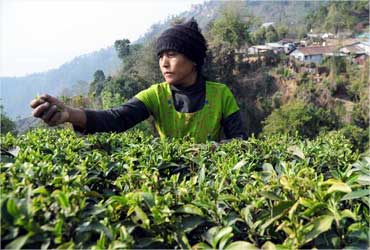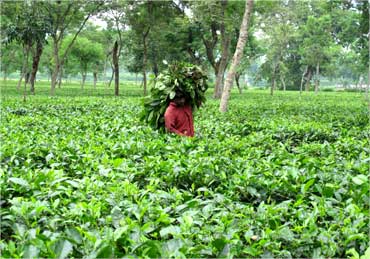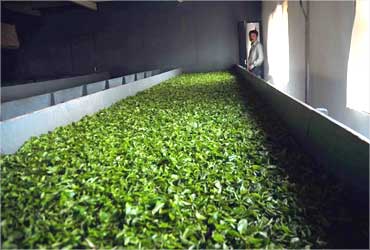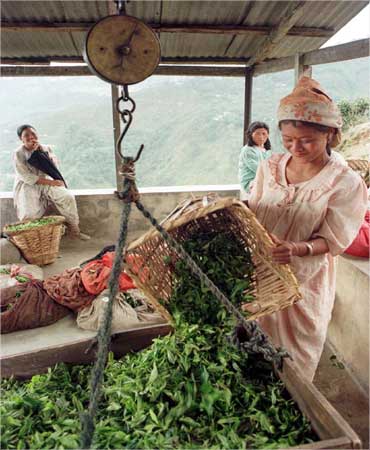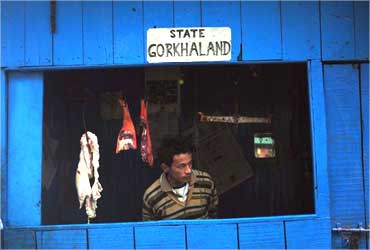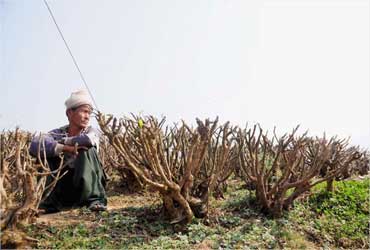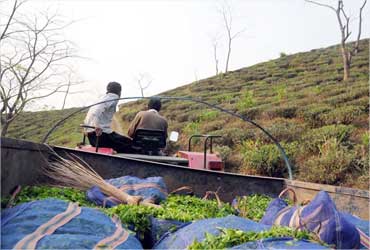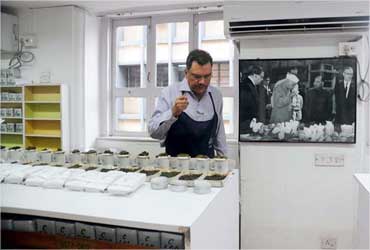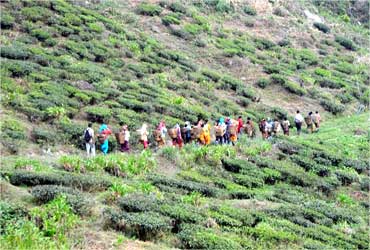 | « Back to article | Print this article |
They earn Rs 5.75 & the tea sells for Rs 25K
Tea grown on the steep slopes of Darjeeling hills, connoisseurs swear, is unlike anywhere else in the world.
Epicures use a plethora of adjectives to describe the 'champagne of teas': brisk, flowery, round, mellow and sparkling.
Brewed properly, the Darjeeling tea leaves yield a thin-bodied, light-coloured liquor with a floral aroma and a musky spiciness leading tea connoisseurs to label a variety of the tea as muscatel.
At the luxury Harrod's store in London a muscatel retails at over Rs 9,000 a kg.
The famed Makaibari gardens sell what the estate calls the world's most expensive tea - Silver Tips Imperial. Reputed to "cull one to celestial slumber", it is priced at $20 (Rs 900) for a 50 gm pack.
On February 27, this year, Gorkha Janmukti Morcha's (GJM) plantation labour union - the only union in the hills - put a spanner in the wheels of this high-end business.
It placed an embargo on dispatches of the premium first harvest of the gardens, called the "first flush".
Click NEXT to read on . . .
They earn Rs 5.75 & the tea sells for Rs 25K
The union demanded a steep raise in the daily wages of tea labourers: from Rs 67 to Rs 120.
After a month-long standoff, the garden owners bowed to the politically strong labour union. The wages were increased to Rs 90.
Behind the one-time jump of Rs 23 - compared to a pitiful raise of Rs 14 in the past 11 years - is a story of Darjeeling's ethnic politics getting intertwined with labour issues in the tea gardens.
The hilly district in north West Bengal has witnessed much political and economic upheaval in the past three decades.
The violent movement for a Gorkha state, Gorkhaland, in the 1980s led to the creation of an autonomous body to administer Darjeeling district, the Gorkha Hill Council.
Barely had political trouble abated, the tea gardens were overtaken by an economic crisis with tea exports plummeting after the collapse of the Soviet Union.
The turnaround came in 2004 after Darjeeling tea acquired a Geographical Indication status (GI).
Click NEXT to read on . . .
They earn Rs 5.75 & the tea sells for Rs 25K
A first for India, the status implied that the country's tea board would certify only the tea grown in the area as Darjeeling tea - much like wine can be produced and sold under the Champagne brand only if it originates in France's Champagne district.
Armed with the GI tag, a bunch of entrepreneurs orchestrated an organic makeover to cater to the discerning consumers of the US, Europe, UK and Japan.
The marketing success of organic- fair-trade-Darjeeling tea did translate into premium prices, but it required a resurgence in identity politics for the predominantly Gorkha labourers to have a share in the pie.
Identity politics
Prashant Tamang - ethnic Gorkha and a Kolkata police constable - was an underdog in the 2007 music reality show, Indian Idol.
A wave of support from the Darjeeling hills turned the tide in Tamang's favour.
Bimal Gurung, a one-time protege of the Gorkhaland movement leader Subhas Ghising, rode this surge of ethnic brotherhood to form the Gorkha Janmukti Morcha (GJM) that renewed the more-than-two-decade- long demand for statehood for 700,000 Gorkhas of Darjeeling district.
Click NEXT to read on . . .
They earn Rs 5.75 & the tea sells for Rs 25K
In the past few months GJM has stormed the tea estates with a demand for wage raise, ostensibly to garner support of the resident vote bank, ahead of the Assembly elections.
A few days before the polling on April 18, Suraj Subba, general secretary of the morcharun plantation labour union said in an upbeat voice, "They had to increase the wages. After the elections we will press the Union home ministry for transferring the land revenue department to the Gorkha Hill Council."
For the GJM, the transfer would mean the power to effect two major changes.
First, the council will be able to confer land rights on people of the district's predominant ethnic group, Gorkhas.
Constituting 80 per cent of the district's population, most Gorkhas spend nearly all their lives in the tea estates.
Since the estates are deemed government land leased to planters, the workers have no land titles. Secondly, the council can tighten its hold over the planters by increasing the hitherto nominal land rent tea estates pay for the lease.
Click NEXT to read on . . .
They earn Rs 5.75 & the tea sells for Rs 25K
Organic by compulsion
Tea cultivation in Darjeeling began in the 1840s after a colonial official experimented with tea seeds in his garden in what was then a sparsely populated hill resort for the affluent.
Commercial plantations mushroomed in the next two decades. Plantations required workers to plant, tend, pluck and finally manufacture the tea - a labour-intensive process which continues till today.
The steady supply of cheap labour came from across the border in Nepal.
The turning point came in 1971 when Russia became the bulk importer of Indian tea.
An assured market made the planters sacrifice quality for quantity. Chemical fertilisers and pesticides were used for the first time in tea estates to boost productivity.
Click NEXT to read on . . .
They earn Rs 5.75 & the tea sells for Rs 25K
Post 1991, with the breakup of Soviet Union - and new producers like Kenya and Sri Lanka entering the market - the demand for the tea suddenly dwindled.
"It was during this time that Europe became quality conscious, with standards for chemical and pesticide residues introduced for food items. The famed Darjeeling tea could not be marketed there," says Sanjay Bansal of the Ambootia Tea Group. "The entire tea industry shared the fate."
Unable to deal with the stress some gardens discontinued use of chemical fertilisers - simply to cut cost - while others were closed and finally abandoned. Within a decade several gardens became "organic by default".
The next big change came around 2000 when a handful of entrepreneurs bought a host of the "sick and abandoned gardens" and converted Darjeeling into a niche brand.
Ashok Lohia of the Chamong group, for instance, bought 11 gardens between 2001 and 2004. "For the industry, the real challenge was to prevent misuse of the brand. The tea estates were certainly not benefiting," he says.
Click NEXT to read on . . .
They earn Rs 5.75 & the tea sells for Rs 25K
While Darjeeling produced barely 10 million kg in a year, world over an estimated 40 million kg was sold in its name.
A painstaking campaign later, Darjeeling got the geographical indication status in 2004.
Simultaneously, to cater to the discerning international consumer, gardens started an organic transition.
Today 38 gardens, accounting for more than half of the tea grown in the region, are chemical-free.
The secret price
Drinking fine tea requires a fine etiquette. Not so if one is a tea-taster.
He doesn't sip, but takes the brew in with a loud slurp and spits it out. In that split second as the brew touches his upper palate the flavours and faults are screened.
A hurried assistant notes down the qualities of the tea and the price it can fetch at auctions.
Click NEXT to read on . . .
They earn Rs 5.75 & the tea sells for Rs 25K
But most Darjeeling gardens no longer depend on auctions to sell their best produce.
"The auction scene has changed a lot in the past few years. In 2010 only 38 per cent of the total produce was sold through auctions, the rest was direct overseas sales. It is only small players who seek our help to market their produce," says Samar Sircar, managing director of Contemporary Brokers at Kolkata.
From the onset of spring as gardens open for harvest to the winter months when gardens shut, the colour, aroma and taste of Darjeeling tea changes. And so does the price.
The first and second flush, harvested between February and April, are prime teas for which international buyers pay a premium.
Tea estates earn 70 per cent of the revenues during this period. But prices remain a closely guarded secret.
A senior member of the Darjeeling Tea Association says, "The planters play cards close to their chest. Not even managers of tea estates know the price the prime first or second flush tea is selling for."
The prices are not disclosed, presumably for two reasons.
Click NEXT to read on . . .
They earn Rs 5.75 & the tea sells for Rs 25K
The planters do not want the workers to know lest they demand a share or another garden undercuts and poaches on private buyers in a fiercely competitive market.
Retail prices are only indicative. Nathmulls, a well known retailer from Darjeeling, was selling the first flush tea from the 2010 season at prices between Rs 2,000 and Rs 15,000 a kg.
Goodricke was selling last year's tea from their best gardens - Margaret's Hope and Castleton - at Rs 4,500 a kg.
In comparison, the not-so-premium rains and autumn teas sell between Rs 150 and Rs 350 per kg in domestic auctions.
"Innovation, along with quality and marketing, is the key to surviving today," Ambootia tea chairperson Sanjay Bansal, told Time magazine in a November 2007 interview.
"That's how I'm able to demand ridiculous prices for my teas." The magazine wrote: "Darjeeling tea, for instance, can be sold for up to 10 times the... other Indian teas, and Ambootia's Brumes d'Himalaya, a first flush, or spring-harvest tea, sold at a high-end boutique in Paris two years ago for $1,750 per kg."
Click NEXT to read on . . .
They earn Rs 5.75 & the tea sells for Rs 25K
Fuelling distrust
"Everyone says Darjeeling is selling at high prices abroad. But I have no idea how much the four kg of tea leaves I plucked today will sell for," says Radha Thakuri, a plucker at the Phoobsering tea estate.
"Shunne me aya hai ki pachhis hazaar me bik raha hai (We have come to know the tea is selling for Rs 25,000 per kg)," adds Rakesh Sarki, a labourer at Happy Valley tea estate.
"If the estates are earning so much is it wrong on our part to demand a fair deal? The planters say they pay for medical and housing, but look around and you will know the truth. At least we have the labour union fighting on our behalf," Sarki adds.
"For Darjeeling the survival model is through elimination of brokers and direct marketing. As for private sales (not through auction), rest assured it is not more than 25 per cent of the retail prices in international market.
Besides, I don't understand how workers are going to benefit if I reveal the prices," says Ashok Lohia, owner of 13 gardens and the largest producer of Darjeeling tea.
All tea estates are governed by the Plantation Labour Act, 1951, which lays down the welfare guidelines for workers.
Click NEXT to read on . . .
They earn Rs 5.75 & the tea sells for Rs 25K
According to the Act, estates are required to provide workers with "necessary housing accommodation" and medical facilities as prescribed by the state government".
Tea estate managers and owners think the Plantation Labour Act has outlived its utility. Such benefits, they say, hurt the industry's competitiveness.
Beyond the recent wage hike, a temporary plucker still earns Rs 5.75 for every kg of tea leaves she plucks (in a day she can pluck no more than six kg). For Radha Thakuri, the success of brand Darjeeling meant precious little.
Radha got married in the Phoobsering tea estate when she was 16. She turned a plucker 21 months later, when her husband passed away after a night of acute stomach pain.
At her hovel of rusted tin sheets with holes all along the roof, she says, "Every time it snows or rains, I have to run with my 12-year-old son to benevolent neighbours for a place to pass the night."
Click NEXT to read on . . .
They earn Rs 5.75 & the tea sells for Rs 25K
Every time she falls ill, Radha has to climb three kilometres to report to the estate health centre. Otherwise, the 14 days of sick wages Radha is entitled to in a year won't be counted.
Last time she was admitted to a nearby hospital - she spent Rs 2,500 - and came back when doctors told her to get operated for gall bladder stone.
The estate never reimbursed her medical expenses. But Radha remains cheerful and says, "When the wind gets strong my house starts dancing. I have told the manager if you don't repair my house this year, I will come and stay at your house."
Radha voted for the Assembly elections on April 18. But she is more worried about her house than a separate state of Gorkhaland.
